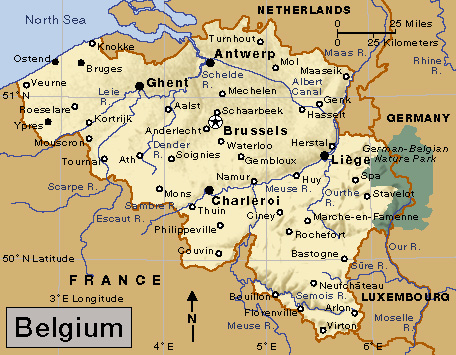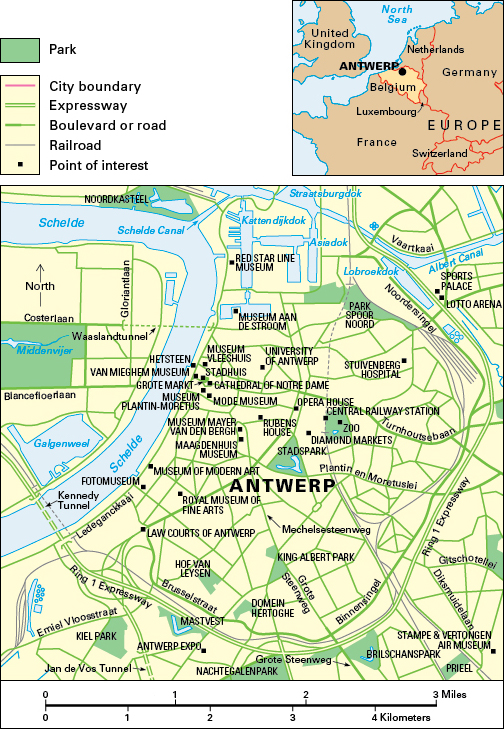Antwerp, << ANT wuhrp >> (pop. 513,570), is Belgium’s largest city and its main port. Antwerp is one of the major ports of Europe. It is called Antwerpen << AHNT vehr puhn >> in Flemish and Anvers << ahn VEHR >> in French.

Antwerp lies on the Schelde River, 55 miles (89 kilometers) from the North Sea. Its waterways and railways serve all Belgium and industrial cities in Germany and France. The harbor at Antwerp is one of the world’s largest. Besides its vast trade, the city has many industries, including sugar refining, lace making, brewing, distilling, and shipbuilding. It is also the world’s largest diamond-trading center.
Chief buildings.
Antwerp’s Cathedral of Our Lady is the largest Gothic church in Belgium and often considered the most beautiful. Its graceful tower rises over 400 feet (120 meters) above the surrounding plain. The cathedral was constructed in sections from 1352 to 1520 and houses masterpieces by Flemish artist Peter Paul Rubens. The large Renaissance town hall, or Stadhuis, was built in the 1560’s as a monument to the city’s wealth. It stands on the main square, Grote Markt, facing the elaborate, Gothic facades of the guild houses. Most of these were also built in the 1500’s. Antwerp’s fine arts museum includes priceless works by Rubens, Anthony Van Dyck, and Jacob Jordaens. The beautiful mansion and gardens of the Rubens House contain more of the artist’s works and the studio where he created them.

History.
Antwerp became a great port of trade between the European mainland and England in the 1400’s. During the 1500’s, Antwerp was one of the world’s richest cities and the chief money market of Europe. The first stock exchange was set up there in 1531. Antwerp reached the height of its prosperity about 1560. The Eighty Years’ War (1568-1648) then plunged the city and the surrounding country into turmoil, as the Dutch provinces fought for—and gained—independence from Spain.
Antwerp declined steadily until 1800, when its population fell below 40,000. The French ruler Napoleon I, realizing its strategic and commercial value, decided to open and improve its harbor and to set it up as a rival to London. The trade of Antwerp grew rapidly until 1830, when Belgium separated from Holland. The Dutch, who controlled the Schelde estuary upon which Antwerp is located, imposed heavy tolls upon shipping. These tolls were abolished in 1863, and the city’s trade recovered.
Antwerp was for a long time the key fortress in the national defense of Belgium, and one of the strongest fortresses in Europe. But modern artillery enabled the Germans to capture and occupy Antwerp in World War I (1914-1918). In May 1940, during World War II (1939-1945), German troops occupied the city. They mined the harbor, planning to destroy the installations upon retreating. But daring Belgian underground workers prevented the explosions when the Allies liberated Antwerp in September 1944. The city was heavily damaged in the fighting, but the port’s survival was key to European recovery after the war.

See also Belgium ; Rubens, Peter Paul ; Van Dyck, Sir Anthony .
